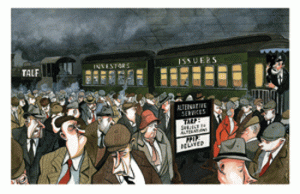
Yesterday President Obama held a banking summit in Washington DC. Mr. Obama wanted to use the occasion to shame the "fat cat bankers" to expand their lending activities to SMEs. A few of the bigger cats were no shows. They got fogged in at Kennedy Airport. They called in to attend the summit by phone. Clearly shame was not the correct motivational devise to encourage the bankers to begin lending to SMEs. Perhaps the President should have appealed to the bankers sense of patriotism; because now is the time that all good bankers must come to the aid of their country. Failing that, perhaps Mr. Obama should make a business case that SME lending is good for profits. A vibrant SME sector is a powerful driver for wealth creation and economic recovery. A beneficial and perhaps unintended consequence of this endeavor is the economic security and political stability of the nation. These are the worthy concerns of all true patriots and form a common ground where bankers and government can engage the issues that undermine our national security.
The withdrawal of $210 billion in credit from the market is a major impediment for economic growth. The trend to delever credit exposures is a consequence of the credit bubble and is a sign of prudent management of credit risk. But the reduction of lending activity impedes economic activity and poses barriers to SME capital formation. If the third quarter reduction in credit withdrawal were annualized the amount of capital removed from the credit markets is about 7% of GDP. This coupled with the declining business revenues due to recession creates a huge headwind for SMEs. It is believed that 14% of SMEs are in distress and without expanded access to credit, defaults and bankruptcies will continue to rise. Massive business failures by SMEs shrinks market opportunities for banks and threatens their financial health and long term sustainability.
The number one reason why financial institutions turn down a SME for business loans is due to risk assessment. A bank will look at a number of factors to determine how likely a business will or will not be able to return the money it has borrowed.
SME business managers must conduct a thorough risk assessment if it wishes to attract loan capital from banks. Uncovering the risks and opportunities associated with products and markets, business functions, macroeconomic risks and understanding the critical success factors and measurements that create competitive advantage are cornerstones of effective risk management. Bankers need assurances that managers understand the market dynamics and risk factors present in their business and how they will be managed to repay credit providers. Bankers need confidence that managers have identified the key initiatives that maintain profitability. Bankers will gladly extend credit to SMEs that can validate that credit capital is being deployed effectively by astute managers. Bankers will approve loans when they are confident that SME managers are making prudent capital allocation decisions that are based on a diligent risk/reward assessment.
On a macro level SME managers must vastly improve their risk management and corporate governance cultures to attract the credit capital of banks. Through programs like the Profit|Optimizer, SME's can position themselves to participate in credit markets with the full faith of friendly bankers. SME lending is a critical pillar to a sustained economic recovery and stability of our banking system. Now is the time for all bankers to come to the aid of their country by opening up credit channels to SMEs to restore economic growth and the wealth of our nation.
You Tube Music Video: Bruce Springsteen, Seeger Sessions, Pay Me My Money Down
Risk: banking, credit, SME



















